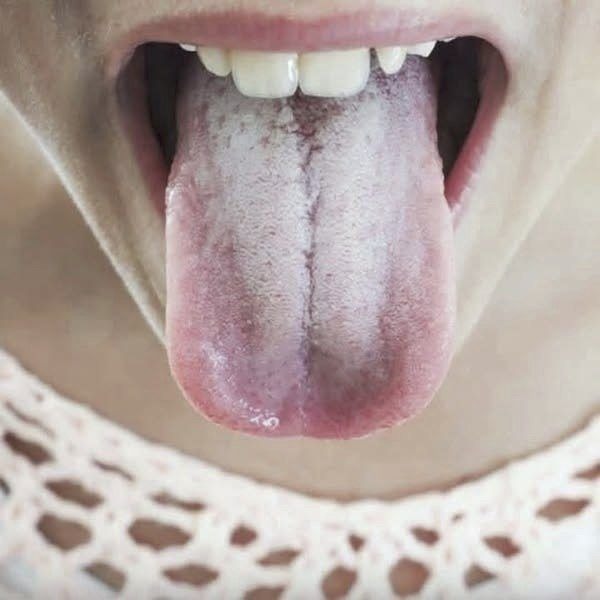4. Leukoplakia
- Description : Thick, white patches on the tongue or inside the mouth caused by chronic irritation (e.g., smoking, rough teeth, or ill-fitting dentures).
- Concern : While usually harmless, leukoplakia can sometimes develop into oral cancer.
- Treatment : Regular monitoring by a dentist; removal of irritants and, in severe cases, surgical intervention.
5. Geographic Tongue
- Description : A harmless condition where parts of the tongue lose their papillae, creating smooth, red areas surrounded by white borders.
- Symptoms : Changing patterns on the tongue; occasional mild discomfort or sensitivity to spicy foods.
- Treatment : No specific treatment is needed, but topical ointments can relieve discomfort.
6. Lichen Planus
-
- Description : A chronic inflammatory condition that affects the mucous membranes, causing white, lacy patches inside the mouth.
- Cause : Likely linked to an immune system disorder.
- Treatment : Corticosteroids or other medications prescribed by a doctor to manage symptoms
7. Syphilis (Secondary Stage)
- Description : A sexually transmitted infection that can cause white patches on the tongue and mouth during its secondary stage.
- Symptoms : Additional signs include fever, rash, and swollen lymph nodes.
- Treatment : Immediate medical attention and antibiotic therapy (penicillin).
When to See a Doctor
While a white tongue is often harmless, seek medical advice if you experience any of the following
- The white coating persists for more than two weeks despite good oral hygiene.
- Pain, burning sensations, or difficulty swallowing accompany the white tongue.
- Red patches, sores, or bleeding occur alongside the discoloration.
- You have an underlying health condition (e.g., diabetes, HIV/AIDS) or a weakened immune system.
Treatment and Prevention Tips
1. Maintain Good Oral Hygiene
- Brush your teeth at least twice a day and clean your tongue with a scraper or toothbrush.
- Use an antibacterial mouthwash to reduce bacteria and prevent plaque buildup.
2. Stay Hydrated
- Drink plenty of water throughout the day to keep your mouth moist and prevent dryness.
3. Avoid Tobacco and Alcohol
- Smoking and excessive alcohol consumption can irritate the mouth and contribute to white patches.
4. Eat a Balanced Diet
- Nutrient deficiencies, particularly vitamin B12, iron, and folate, can affect oral health. Include fruits, vegetables, lean proteins, and whole grains in your diet.
5. Visit Your Dentist Regularly
- Routine dental check-ups can help detect early signs of oral health issues and ensure timely treatment.
6. Address Underlying Conditions
- If you have a chronic condition like diabetes, work closely with your healthcare provider to manage it effectively.
Conclusion
A white tongue can result from a variety of causes, ranging from minor issues like dehydration to more serious conditions like oral thrush or leukoplakia. By practicing good oral hygiene, staying hydrated, and addressing any underlying health concerns, you can often resolve the issue naturally. However, persistent or painful symptoms should always be evaluated by a healthcare professional to rule out serious conditions.
If you notice a white tongue that doesn’t improve with self-care measures, don’t hesitate to consult your doctor or dentist. Early diagnosis and treatment are key to maintaining optimal oral and overall health.

